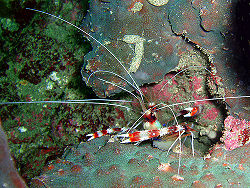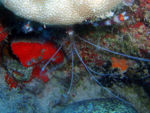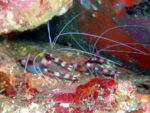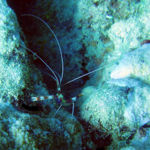Banded coral shrimp
| Banded coral shrimp |
|---|
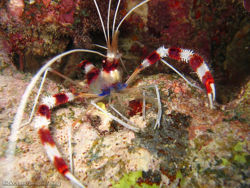
|
| Scientific Classification |
|
| Binomial Name |
|
Stenopus hispidus |
The Banded Coral Shrimp is also known as the Banded Cleaner Shrimp and Banded Boxing Shrimp. It gets this name because its antennae are usually held up like a boxer's hands. [1] They are able to re-grow limbs that are lost when they molt and this sometimes causes their claws to be different sizes. [2] This crustacean finds its life partner when its young and stays with their mate through most of their life. They cannot tolerate any other from the same species besides their mate. [3] The Banded Coral Shrimp is treated as a V.I.P. because it is kept completely safe as it is allowed into the gill cavities and mouth of other, more vicious animals such as morays, tangs, grunts and groupers.[4]
Click Here To view a video of the Banded Coral Shrimp cleaning.
Anatomy
The Banded Coral Shrimp gets its name because it has red, sometimes purple, [5] and white bands all across its body. The body is usually no longer than three inches and the length of the excessive antennae almost double its length to six inches. [6] These antennae are hair-like structures [7] used to signal to other animals that it is available to clean them. Its pinchers are long which is useful for its job. The male is typically smaller than the female in this species. [8] It is a typical crustacean in that it has five pairs of legs, the first pair is the pinchers and the rest are the swimmerets. [9] Its body has bilateral symmetry. Their claws can fall off to distract prey when they feel threatened and it will regenerate the next time it molts (about every 3-8 weeks), but this often leads to unequal size of the claws. [10]
Reproduction
The Banded Coral Shrimp, also known as the Banded Cleaner Shrimp, breeds year round. They find their mates when they are young and stay together for years. They molt around every 3-8 weeks. Immediately following molting, the female reproduces. [11] The male does an elaborate dance, positions himself on top of the female, and releases a sperm-pac that will be laid later. [12] When the greenish eggs are laid they are attached along the swimmerets which are the little legs, behind the claws. [13] The eggs hatch about 16 weeks later and still stay attached to their mother. About 6 weeks later they leave the mother, as plankton, until they molt. [14]
Ecology
The Banded Coral Shrimp is one of the most evenly distributed animals of the sea. [15] It is found from the Red Sea and southern Africa to the Hawaiian Tuamotu. They are also found in the western Atlantic, from Bermuda and off the coast of North Carolina to the Gulf of Mexico and southern Florida to the northern coast of South America. This crustacean typically lives about 40 feet below sea level [16] but has been seen much deeper than that. It lives in the crevices and rocky ledges but it also likes living in abandoned man-made objects. [17] It typically hangs upside down in caves or crevices with its antennae emerging or waving from the hole, signaling to the other animals that it is ready to clean them. [18] Fish are attracted to this shrimp’s bright colors and will form groups as they are waiting to be cleaned. The Banded Coral Shrimp crawls all over the body to remove dead skin and scales. [19] They are scavengers who eat parasites when presented with them. [20] It cleans off particles from coral reef fish. It is not typically consumed by other animals but it has been seen in the bellies of Epinephalus merra. The, sometimes vicious, animals allow the Banded Coral Shrimp into their mouth and gill cavities without harming them. The animals they clean include: morays, tangs, grunts and groupers. [21]
Owning one as a Pet
These territorial shrimp are the most common ones in saltwater aquariums. They work very well in miniature reef aquariums [22] if they can have enough room for their antennae without touching any other plants, animals, or walls near them. They are not tolerant of crustaceans of the same species unless it is a true mated pair that they are placed with from the start. The iodine levels are very important to be kept normal otherwise the molting schedule or its normalcy will be altered. If there is chemical imbalance in the aquarium, they can go into shock. Most will not reproduce successfully in an aquarium because the eggs are typically destroyed in the filtration system. In the wild there are scavengers but in captivity they eat flaked fish food. [23] It will be eaten by triggerfish and eels if the opportunity arises and it will eat worms, snails and small hermit crabs. It likes the protection of a cave or somewhere it can hide in the daylight. [24]
 Browse |
References
- Banded Coral Shrimp Liveaquaria.com.
- Coral Banded Shrimp By Stan & Debbie Hauter. About.com.
- Banded Coral Shrimp at The Strip, Bimini By Dr. Jonathan Dowell. ReefNews ®, Inc.
- Stenopus hispidus banded coral shrimp By Kristen Sanderson. Animal Diversity Web.
- The Banded Coral Shrimp, Stenopus hispidus By Bob Fenner. AquaC.
- Shrimp- Banded coral CentralPets.com
